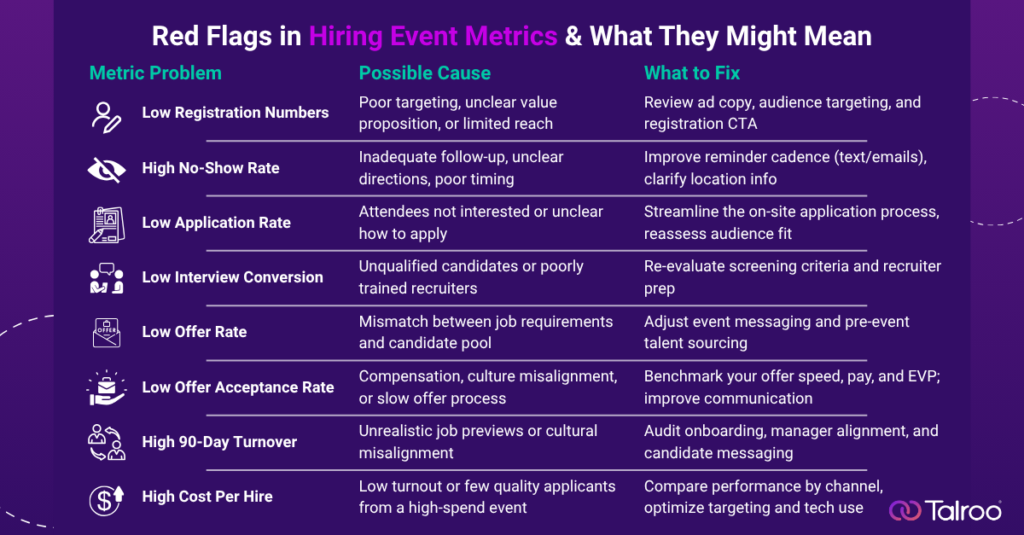
Planning a successful hiring event begins well before you book a venue or launch a campaign. To improve each event and demonstrate return on investment (ROI), you need to collect, analyze, and act on key performance metrics. The right data reveals what worked, what didn’t, and where improvements are needed. In 2025, when recruiting budgets are tight and competition for talent remains high, data-driven hiring events are a necessity.
What should you measure to determine the success of your event? We have a guide to the hiring event metrics that matter most for today’s talent acquisition professionals, along with tips on how to use technology to get the most from your data.
Related: The Complete Hiring Events Playbook | Talroo
Start with a Strategy and Set Benchmarks
Before your next hiring event, take time to review data from previous events. If you are just starting, use your first event to establish a baseline. A successful strategy begins with clearly defined goals and measurable performance indicators. Key data points to track include:
- Number of event registrants
- Number of actual attendees
- Number of applications or resumes submitted
- Percentage of qualified candidates
- Interviews scheduled during or after the event
- Job offers extended and accepted
- Hires made from the event
- Retention rates for event hires (such as at 30, 60, and 90 days)
Establishing benchmarks for these metrics allows you to evaluate your performance over time and make informed decisions moving forward.
How Technology Improves Hiring Event Results
Modern event platforms and recruitment tools can make it easier to manage data, often in real time. Technology can help improve outcomes and enhance the candidate experience in several ways, including:
- Targeted Promotion: Using programmatic advertising and customer relationship management (CRM) tools, you can reach the right audience and reduce cost per attendee while improving candidate quality.
- Automated Communication: With automated emails and text reminders, you can increase attendance and ensure candidates arrive prepared.
- Streamlined Registration and Application: Mobile-friendly sign-ups and QR-code applications reduce friction and improve conversion rates.
- Live Event Dashboards: Real-time dashboards help recruiters track performance, such as check-ins and interviews, and make quick adjustments during the event.
Why It’s Important to Know Your Source of Hire
One major benefit of hiring events is that you can clearly identify the source of hire. While many applicant tracking systems rely on candidates to self-report how they found a job, hiring events provide a more accurate data trail.
Using tracking links with UTM parameters in your event ads and application pages allows you to gather precise insights, including the effectiveness of your event promotions and any spillover impact from candidates who apply later online after seeing your event.
Top Hiring Event Metrics to Monitor

Here are the most important metrics for assessing your hiring event’s success and guiding your next steps:
1. Attendance Rate
Formula: Attendees ÷ Registrants
This metric helps you understand the effectiveness of your outreach and reminder efforts. Low attendance may suggest poor communication, scheduling conflicts, or misaligned messaging.
2. Application Rate
Formula: Applications Submitted ÷ Attendees
This indicates how compelling your roles were to those who attended. If this number is low, consider whether the event attracted the right audience or if the application process needs to be improved.
3. Interview Rate
Formula: Interviews Conducted ÷ Applications
If few candidates progressed to interviews, your team may need to improve how they screen or engage with talent during the event.
4. Offer Rate
Formula: Offers Made ÷ Interviews
This reflects the success of your interview process and whether you attracted qualified candidates.
5. Offer Acceptance Rate
Formula: Offers Accepted ÷ Offers Made
A high acceptance rate suggests strong alignment between your job offers and candidate expectations. A low rate might point to issues with compensation, culture, or communication.
6. Hire Rate
Formula: Hires ÷ Attendees
This is one of the clearest indicators of your event’s effectiveness in converting interest into employment.
7. Cost per Attendee and Cost per Hire
Formulas:
- Cost per Attendee: Total Event Spend ÷ Number of Attendees
- Cost per Hire: Total Event Spend ÷ Number of Hires
These figures help you evaluate your event’s financial efficiency. Comparing them to other sourcing channels, such as job boards or recruitment agencies, can help guide future budget allocations.
8. Retention by Source
Track how long event hires stay with your organization. If many leave within 90 days, there may be a disconnect between how the job or company was presented and the actual experience.
Improve with Feedback and Post-Event Analysis
Collecting feedback is just as important as tracking metrics. Send brief surveys to all registrants, separating attendees from no-shows, to get a better understanding of the candidate experience.
Ask questions such as:
- Was the event easy to navigate?
- Did the application process make sense?
- Did the job roles meet expectations?
- Was the employer brand clearly communicated?
Use the feedback alongside your event metrics to refine every part of your hiring strategy, from targeting and promotion to follow-up and onboarding.
Final Thoughts: Make Every Event Better Than the Last
Hiring events can be powerful tools for attracting talent, especially when they are guided by meaningful metrics. By tracking and analyzing data from each stage of the event, talent acquisition professionals can improve their hiring processes, deliver a better candidate experience, and maximize ROI.
Whether you are planning a large-scale career fair or a niche recruiting open house, a clear plan and the right data will help ensure that your next hiring event is not only well attended but also highly effective.



